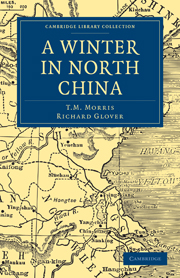Book contents
- Frontmatter
- INTRODUCTION
- AUTHOR'S PREFACE
- MAP OF THAT PART OF CHINA VISITED BY DR. GLOVER AND THE REV. T. M. MORRIS.
- Contents
- CHAPTER I FROM SAN FRANCISCO TO YOKOHAMA
- CHAPTER II CHEFOO AND TIEN-TSIN
- CHAPTER III FROM TIEN-TSIN TO TSING-CHOW-FU
- CHAPTER IV TSING-CHOW-FU
- CHAPTER V CHOW-PING
- CHAPTER VI CHI-NAN-FU
- CHAPTER VII THE GREAT PLAIN OF CHINA
- CHAPTER VIII T'AI-YUEN-FU
- CHAPTER IX PEKING
- CHAPTER X AN INTERVIEW WITH LI-HUNG-CHANG
- CHAPTER XI SHANGHAI
- CHAPTER XII HANKOW, HONG-KONG, AND CANTON
- CHAPTER XIII THE RELIGIONS OF CHINA
- CHAPTER XIV FUNG-SHUI
- CHAPTER XV MISSIONARY WORK AND METHODS IN CHINA
- APPENDIX
CHAPTER VII - THE GREAT PLAIN OF CHINA
Published online by Cambridge University Press: 05 August 2011
- Frontmatter
- INTRODUCTION
- AUTHOR'S PREFACE
- MAP OF THAT PART OF CHINA VISITED BY DR. GLOVER AND THE REV. T. M. MORRIS.
- Contents
- CHAPTER I FROM SAN FRANCISCO TO YOKOHAMA
- CHAPTER II CHEFOO AND TIEN-TSIN
- CHAPTER III FROM TIEN-TSIN TO TSING-CHOW-FU
- CHAPTER IV TSING-CHOW-FU
- CHAPTER V CHOW-PING
- CHAPTER VI CHI-NAN-FU
- CHAPTER VII THE GREAT PLAIN OF CHINA
- CHAPTER VIII T'AI-YUEN-FU
- CHAPTER IX PEKING
- CHAPTER X AN INTERVIEW WITH LI-HUNG-CHANG
- CHAPTER XI SHANGHAI
- CHAPTER XII HANKOW, HONG-KONG, AND CANTON
- CHAPTER XIII THE RELIGIONS OF CHINA
- CHAPTER XIV FUNG-SHUI
- CHAPTER XV MISSIONARY WORK AND METHODS IN CHINA
- APPENDIX
Summary
On leaving Hsiao-Chang, our journey lay through the northern part of the Great Plain of China. This immense plain, which forms so large and important a part of China, is made up of the united deltas of China's two great rivers–the Yang-tze-Kiang and the Hwang-ho. Its greatest length is about seven hundred miles, and its greatest width nearly five hundred miles, with an average width of three hundred miles, with a coast-line of nearly 1100 miles; its superficial area has been variously estimated at from 150,000 to 180,000 square miles. It is, for the most part, as level as our own Fen district, and almost entirely bare of trees. If looking across the plain you see trees, you may be nearly sure that they mark the site of some town or village, or the margin of some stream, or some burial enclosure. In China burial-grounds are private, and are met with everywhere, and evergreen trees, such as the pine, arbor vitae, and cypress, are planted in double rows round the burial-places of wealthier families. The graves of the poor are marked by nothing more than conical heaps of earth about the size of an English haycock. The naturally barren appearance of the plain at this season, when the wheat is only a few inches above the ground, is increased by the fact that animals seem to be freely allowed to nibble off the tops of the growing plant.
- Type
- Chapter
- Information
- A Winter in North China , pp. 98 - 116Publisher: Cambridge University PressPrint publication year: 2010First published in: 1892

